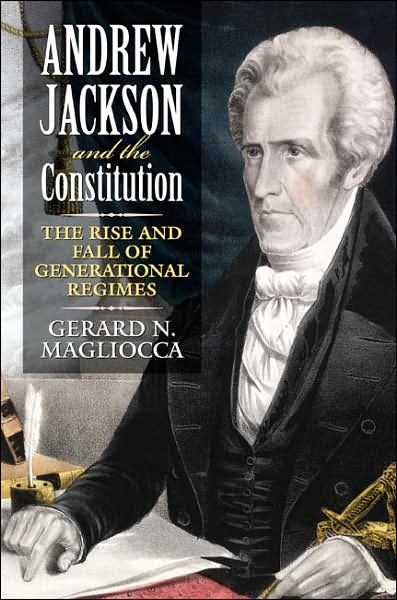Are We Near a Constitutional Turning Point?
When Americans think about constitutional law, they almost always focus on the Supreme Court. And with the recent appointments of Chief Justice John Roberts and Justice Samuel Alito, many observers believe that the Court is about to embark on a new conservative era. More powerful forces at work outside of the Court, however, suggest that a different constitutional change may be at hand – the dissolution of the coalition built by Ronald Reagan and its replacement by a new political order.
Constitutional law moves in cycles driven by the unique experiences of each generation. My new book, Andrew Jackson and the Constitution: The Rise and Fall of Generational Regimes, explores how this cycle unfolded for the Jacksonian Democrats that governed from the 1830s until the Civil War and uses that example to develop a broader understanding of how the Constitution changes.
Though each constitutional period is distinctive, there are some fundamental principles that unite them. Every generation of Americans, not just the Founding Fathers, acts to correct abuses tolerated by the legal traditions they inherit. In framing a solution, each new political movement develops constitutional ideas tailored to the problems that it confronts. Once established, this consensus sets the boundaries of political debate until voters rethink their allegiance in an electoral realignment. Thus, the Justices are largely carrying out the will of the ruling generation when they interpret the Constitution.
The repetition of this cycle throughout our history contains three important lessons about when these movements end. First, whether one is talking about New Deal Democrats, Reconstruction Republicans, or Jeffersonian Democrats, a constitutional generation typically lasts for about thirty years. This rings true because once voters draw conclusions about a particular set of experiences they tend to keep voting the same way until they die. Second, the electorate as a whole usually reconsiders its party identification only when some transformative moment such as the Civil War or the Great Depression exposes deep faults in existing legal arrangements. Third, when the philosophy of the ruling generation starts to get stale, that movement often responds by nominating an outsider for President who campaigns as a pragmatist who can make things work instead of relying on party dogma.
The current constitutional era was launched by Ronald Reagan’s election in 1980, which swept conservatives into power for the first time in decades and turned the Republican Party into the dominant force in the country. That movement developed in response to the failures of the welfare state and the perceived excesses of the Supreme Court in cases on criminal law and social policy. Though it may be hard to remember, the late 1970s was seen as a time of crisis with the West retreating before communism, rampant inflation smothering the economy, and a general sense of malaise afflicting the nation. We are now almost thirty years removed from these events, and the recent death of Jerry Falwell is a reminder that the leaders and voters who developed their political consciousness during this time are beginning to pass from the scene.
Not only is the conservative era nearing the end of its natural lifespan, but the events of September 11 have undermined the message that brought President Reagan and his heirs to office. In his First Inaugural, Reagan famously explained that “[i]n this present crisis, government is not the solution to our problems. Government is the problem.” Responding to the crisis of terrorism, however, is a quintessential government function that is not well served by the robust understanding of federalism that was an integral part of conservative thought for decades. More broadly, 9/11 and the War in Iraq are causing voters to rethink their priorities in a way that could portend an electoral realignment. The negative impact of 9/11 on the Reagan coalition was masked by the rally to the President in the immediate aftermath of the attacks, but its long-term effect may be more adverse to the GOP.
Finally, the shape of the Republican field in the 2008 election reflects the politics of a fading regime. In a brilliant book written during the 1990s, Stephen Skowronek explained that when a constitutional system ages its ruling party cannot nominate true believers for President if they want to win. The better alternative is to run someone who is loosely affiliated with the political establishment and can plausibly claim that he can make a bad system work through extraordinary managerial skill. Herbert Hoover, for example, was a professional engineer who was known for his exceptional crisis management skills before his election as the last Republican President before the New Deal. Likewise, Jimmy Carter began his career as an engineer and argued that the flaw with modern liberalism was in its administration rather than in its approach, which was encapsulated by his campaign slogan “Why Not the Best?” Needless to say, he was the last Democratic President before the Reagan Revolution.
At the moment, the leading Republican presidential candidate is Rudolph Giuliani, who fits this technocratic model perfectly. Mayor Giuliani is not a party warhorse like Bob Dole, George H.W. Bush, or Newt Gingrich. He does not support longstanding party positions on issues such as abortion. Instead his candidacy rests on his reputation as a “can-do” leader who reduced crime in New York and showed strength after 9/11. One of Giuliani’s rivals is Mitt Romney, who is also an outsider emphasizing his business success and his managerial skills in running the Winter Olympics rather than his beliefs. This may represent a winning formula in 2008, but the profiles of candidates like Giuliani and Romney reflect a basic lack of appeal in the traditional conservative message.
Predicting when and how a political realignment will occur is a tricky business that calls to mind the economist who proudly boasts that she predicted nine of the last three recessions. In determining where the Constitution will go in the near future, however, the places to watch are Iowa and New Hampshire, not the Supreme Court.

